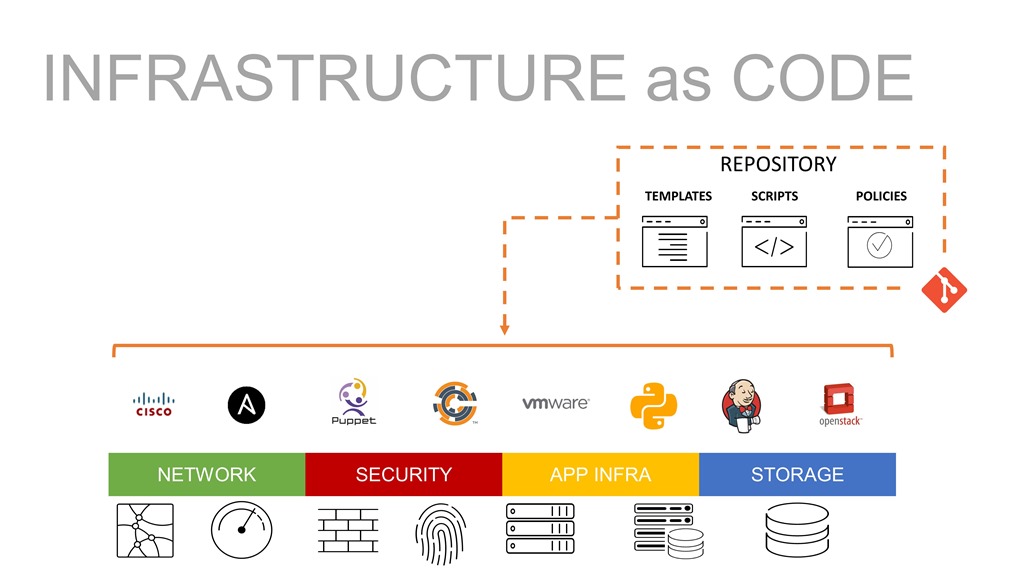NetOps를 위한 코드형 인프라란 무엇인가?
DevOps 접근 방식이 네트워크 운영의 장벽을 넘으면서 새로운 용어도 생겨나고 있습니다. 이러한 구어적 표현은 이전에 접하지 않은 NetOps 담당자에게는 혼란스러울 수 있으며, 이 방법론을 받아들이라는 압박을 받고 있는 IT 임원을 당황하게 할 수 있습니다.
그 중 하나가 코드로서의 인프라라는 개념입니다. 개발자의 세계에서 인프라는 주로 앱이 배포되고 확장되는 플랫폼, 서버, 컨테이너 시스템을 의미합니다. 인프라는 주로 컴퓨팅입니다.
벽의 반대편에는 컴퓨팅 외에도 저장소, 보안, 네트워킹을 아우르는 더 광범위하고 강력한 인프라가 있습니다. 결국에는 4가지 작업이 있으며, 모든 작업이 동기화되어 운영되어야 지속적인 배포를 달성하고 IT 및 비즈니스 리더가 디지털 혁신을 통해 추구하는 최적화를 실현할 수 있습니다. 즉, 코드형 인프라에는 개발 단계보다 운영 단계에서 훨씬 더 광범위한 시스템, 장치 및 서비스가 포함된다는 의미입니다. 일반적으로 앱을 배포하면 4가지 운영 부문 각각의 인프라가 어떤 식으로든 영향을 받게 됩니다. 이로 인해 프로덕션 환경에서 코드로 인프라를 구축하는 것이 조금 더 까다로워지지만, 효율성과 속도에 더 큰 영향을 미칩니다.

자동화를 통해 배포 시 비효율성의 원인이 되는 핸드오프 간 대기 시간을 없앨 수 있기 때문입니다. 특히 수동 프로세스가 휴가, 병가, 점심 시간과 충돌할 때 더욱 그렇습니다.
그것은 비유입니다
코드로서의 인프라는 비유입니다. 즉, 우리는 실제로(적어도 지금은) 네트워크 및 애플리케이션 서비스 시스템을 우리가 빌드한 다음 배포하는 코드로 바꾸고 싶어하지 않는다는 것을 의미합니다. 대부분의 기업 조직에 있어서 이는 엄청난 혼란일 것이고 기업 네트워크의 안정성과 신뢰성을 해칠 것입니다. 하지만 우리는 구성과 프로필을 실행 중인 시스템에서 분리하는 시스템의 이점을 활용하고 싶습니다.
즉, 구성, 정책 및 프로필을 배포된 하드웨어나 소프트웨어에서 분리하는 것을 의미합니다.
이 컬렉션은 "배포 아티팩트"로 간주되며 코드처럼 처리할 수 있습니다. 즉, 저장소에 저장하고 관리하고 버전을 관리하고 검토할 수 있다는 의미입니다. 개발자가 저장소(예: Github)에서 코드를 끌어오고, 복제하고, 커밋하는 것과 같은 방식으로 끌어오고, 복제하고, 커밋할 수 있습니다.
"자동화 아티팩트"도 포함해야 합니다. 이는 귀하가 선택한 자동화 툴킷과 함께 사용할 수 있는 자동화 작업을 설명하는 스크립트와 관련 파일입니다. Ansible이 그렇다면 플레이북이죠. 셰프라면 레시피입니다. 퍼핏에 대한 선언문입니다. 아니면 그냥 일반적인 Python 스크립트일 수도 있습니다.
BIG-IP와 점점 더 많은 네트워크 호스팅 시스템의 경우, 더욱 복잡하거나 표준화된 구성을 추가로 설명할 수 있는 템플릿(iApp)도 포함됩니다. 이 경우 템플릿을 사용하면 핵심 툴셋에서 아직 지원하지 않는 옵션과 애플리케이션 서비스를 지원할 수 있으므로 유리할 수 있습니다.
배포 아티팩트와 함께 자동화 아티팩트는 "코드로서의 인프라"라고 하는 컬렉션을 형성합니다. 시스템을 프로비저닝한 후 자동화 프로세스를 실행하여 원하는 대로 구성할 수 있다고 가정합니다.
네트워크 및 애플리케이션 서비스에 대한 애플리케이션별 접근 방식과 결합하면, 인프라를 코드로 구축하는 방식은 빈번한 배포의 위험을 크게 완화할 수 있습니다. 구성을 분리하고 그 영향을 단일 시스템에 국한시키면 배포가 잘못되어 발생하는 영향이 실질적으로 없어집니다. 그러면 비즈니스 요구 사항과 사용자의 요구 사항에 더 잘 맞는 애플리케이션별 일정이 촉진됩니다.
클라우드를 중시하는 조직의 경우, 인프라를 코드로 구축하는 방식을 사용하면 데이터 센터에서 클라우드로, 클라우드에서 클라우드로 마이그레이션하는 데 따르는 마찰을 줄일 수 있습니다. 구성이 시스템에서 분리되었으므로 표면적으로는 다른 곳의 비슷한 시스템에 배포될 수 있습니다.
인프라를 코드 방식으로 전환하려는 노력을 기울여야 할 만한 이유는 많지만, 그렇지 않아야 할 만한 이유는 거의 없습니다. 코드형 인프라는 멀티 클라우드, 앱 중심 디지털 경제에서 성공하는 데 필요한 민첩한 네트워크 조직을 실현하는 가장 유리한 방법 중 하나입니다.
